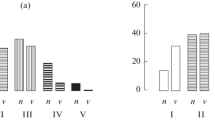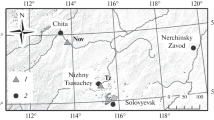Abstract
The degree of development and depth of edge effect are studied in some fragments of forest-park stands under long-term urbanization impact (in the city of Yekaterinburg, Russia) and in natural forests using the method of transect investigation. The method of quantitative assessment of tree stem and crown growth features by a set of morphological characteristics was used. The objects of the research included the edges of Scots pine stands. The edge effect was determined by two of the five studied characteristics: foliation and branchiness, which characterize the level of the development of the tree assimilation apparatus. The general trends indicate an increase in the development of these characters in natural stands and decrease in the forest park at increased distance from the edge. The nonlinear development of morphological characteristics along the transects is due to different types of tree responses on the impact of determining morphogenesis factors. Four statistically significant different zones were identified in the natural stands at distances of 0–75, 100–125, 150–175, and 200–225 m from the forest edge and only two zones were differentiated in the forest park. The unified approach to data analysis suggests the edge effect in both habitats at a distance of 75–100 m from the forest edge according to branchiness and 100–125 m according to foliation. Several types of morphogenetic tree responses, distinguished by the degree of foliation and branchiness variation under edge effect impact, are revealed.




Similar content being viewed by others
REFERENCES
Chen, J., Franklin, J.F., and Spies, T., Vegetation responses to edge environments in old-growth Douglas-fir forests, Ecol. Appl., 1992, vol. 2, no. 4, pp. 387–396. https://doi.org/10.2307/1941873
Harper, K.A. and Macdonald, S.E., Structure and composition of riparian boreal forest: New methods for analyzing edge influence, Ecology, 2001, vol. 82, no. 3, pp. 649–659. https://doi.org/10.1007/S11258-006-9227-2
Harper, K.A. and Macdonald, S.E., Structure and composition of edges next to regenerating clear-cuts in mixed-wood boreal forest, J. Veget. Sci., 2002, vol. 13, no. 4, pp. 535–546. https://doi.org/10.1111/j.1654-1103.2002.tb02080.x
Harper, K.A. and Macdonald, S.E., Quantifying distance of edge influence: A comparison of methods and a new randomization method, Ecosphere, 2011, vol. 2, no. 8, pp. 1–17. https://doi.org/10.1890/ES11-00146.1
Harper, K.A., Macdonald, S.E., Burton, P.J., et al., Edge influence on forest structure and composition in fragmented landscapes, Conserv. Biol., 2005, vol. 19, no. 3, pp. 768–782. https://doi.org/10.1111/j.1523-1739.2005.00045.x
Chen, J., Franklin, J.F., and Spies, T.A., Microclimatic pattern and basic biological responses at the clearcut edges of old-growth Douglas-fir stands, Northw. Environ., 1990, vol. 6, no. 2, pp. 424–425.
Rulev, A.S., Ruleva, O.V., Yuferev, V.G., and Rulev, G.A., Thermodynamics of ecotonal landscapes, Vestn. Voronezh. Gos. Univ., Ser.: Geogr. Geoekol., 2017, no. 4, pp. 5–14.
Murcia, C., Edge effects in fragmented forests: Implications for conservation, Trends Ecol. Evol., 1995, vol. 10, no. 2, pp. 58–62. https://doi.org/10.1016/S0169-5347(00)88977-6
Kellman, M., Redefining roles: Plant community reorganization and species preservation in fragmented systems, Glob. Ecol. Biogeogr. Lett., 1996, vol. 5, no. 3, pp. 111–116. https://doi.org/10.2307/2997393
Pupyrev, E.I., Yakubov, Kh.G., and Avsievich, N.A., Monitoring sostoyaniya zelenykh nasazhdenii v usloviyakh megapolisa (sostoyanie, problemy i perspektivy razvitiya monitoringa v 2000 g. (Monitoring of Green Areas in a Megalopolis: Status, Problems, and Prospects for Development in 2000), Vestn. Mosk. Gos. Univ. Lesa (Lesnoi Vestn.), 2000, no. 6 (15), pp. 12–15.
Shavnin, S.A., Veselkin, D.V., Vorobeichik, E.L., et al., Factors of pine-stand transformation in the city of Yekaterinburg, Contemp. Probl. Ecol., 2016, vol. 9, no. 7, pp. 844–852. https://doi.org/10.1134/S199542551607009X
Veselkin, D.V., Korzhinevskaya, A.A., and Podgaevskaya, E.N., The edge effect on the herb–dwarf shrub layer of urbanized southern taiga forests, Russ. J. Ecol., 2018, vol. 49, no. 6, pp. 465–474. https://doi.org/10.1134/S1067413618060139
Laurance, W.F., Hyperdynamism in fragmented habitats, J. Veget. Sci., 2002, vol. 13, no. 4, pp. 595–602. https://doi.org/10.1111/j.1654-1103.2002.tb02086.x
Kuliesis, A.A. and Kuliesis, A., Edge effect on forest stand growth and development, Baltic Forestry, 2006, vol. 12, no. 2, pp. 158–169.
Reinmann, A.B. and Hutyra, L.R., Edge effects enhance carbon uptake and its vulnerability to climate change in temperate broadleaf forests, Proc. Natl. Acad. Sci. U. S. A., 2017, vol. 114, no. 1, pp. 107–112. https://doi.org/10.1073/pnas.1612369114
Galako, V.A., Shavnin, S.A., Vlasenko, V.E., et al., Specific features of morphological structure of natural pine stands in the city of Yekaterinburg, Izv. Orenburg. Gos. Agr. Univ., 2017, no. 5 (67), pp. 88–90.
Spies, T.A. and Franklin, J.F., Old-growth and forest dynamics in the Douglas-fir region of western Oregon and Washington, Nat. Areas J., 1988, vol. 8, no. 3, pp. 190–201.
Veselkin, D.V., Shavnin, S.A., Vorobeichik, E.L., et al., Edge effects on pine stands in a large city, Russ. J. Ecol., 2017, vol. 48, no. 6, pp. 499–506. https://doi.org/10.1134/S1067413617060121
Shavnin, S.A., Ovchinnikov, I.S., Montile, A.A., and Golikov, D.Yu., Assessment of trunk and crown shape in Scots pine based on a complex of morphological parameters, Lesovedenie, 2019, no. 1, pp. 64–74.
Kolesnikov, B.P., Zubareva, R.S., and Smolonogov, E.P., Lesorastitel’nye usloviya i tipy lesov Sverdlovskoi oblasti. Prakticheskoe rukovodstvo (Site Conditions and Forest Types in Sverdlovsk Oblast: A Practical Guidebook), Sverdlovsk: Ural Nauch. Tsentr Akad. Nauk SSSR, 1974.
Sturman, V.I., Natural and technogenic factors of air pollution in Russian cities, Vestn. Udmurt. Gos. Univ, Ser.: Biol. Nauki o Zemle, 2008, no. 2, pp. 15–29.
Gosudarstvennyi doklad “O sostoyanii i ob okhrane okruzhayushchei sredy Sverdlovskoi oblasti v 2010 g.” (State Report “On the State and Protection of Natural Environment in Sverdlovsk Oblast in the Year 2010”), Yekaterinburg, 2011.
Gosudarstvennyi doklad “O sostoyanii i ob okhrane okruzhayushchei sredy Sverdlovskoi oblasti v 2012 g.” (State Report “On the State and Protection of Natural Environment in Sverdlovsk Oblast in the Year 2012”), Yekaterinburg, 2013.
ACKNOWLEDGMENTS
The authors are grateful to Dr. Sci. (Biol.) D.V. Veselkin for discussions of the problem and direct participation in selecting research objects. The authors are also grateful to the reviewer for providing constructive comments, which made it possible to improve the presentation and content of the article.
Funding
This study was supported by the Integrated Program of the Ural Branch of the Russian Academy of Sciences for 2018–2020 (grant no. 18-4-4-10) and performed under the State Assignment of the Botanical Garden, Ural Branch, Russian Academy of Sciences.
Author information
Authors and Affiliations
Corresponding authors
Additional information
Translated by D. Zabolotny
Rights and permissions
About this article
Cite this article
Shavnin, S.A., Golikov, D.Y., Montile, A.A. et al. Edge Effect: Growth and Morphogenetic Features of Scots Pine Trees in Forest Parks and Natural Stands. Russ J Ecol 51, 199–205 (2020). https://doi.org/10.1134/S1067413620030145
Received:
Revised:
Accepted:
Published:
Issue Date:
DOI: https://doi.org/10.1134/S1067413620030145




